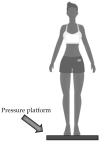Comparison of Machine Learning Algorithms Fed with Mobility-Related and Baropodometric Measurements to Identify Temporomandibular Disorders
- PMID: 38894437
- PMCID: PMC11175253
- DOI: 10.3390/s24113646
Comparison of Machine Learning Algorithms Fed with Mobility-Related and Baropodometric Measurements to Identify Temporomandibular Disorders
Abstract
Temporomandibular disorders (TMDs) refer to a group of conditions that affect the temporomandibular joint, causing pain and dysfunction in the jaw joint and related muscles. The diagnosis of TMDs typically involves clinical assessment through operator-based physical examination, a self-reported questionnaire and imaging studies. To objectivize the measurement of TMD, this study aims at investigating the feasibility of using machine-learning algorithms fed with data gathered from low-cost and portable instruments to identify the presence of TMD in adult subjects. Through this aim, the experimental protocol involved fifty participants, equally distributed between TMD and healthy subjects, acting as a control group. The diagnosis of TMD was performed by a skilled operator through the typical clinical scale. Participants underwent a baropodometric analysis by using a pressure matrix and the evaluation of the cervical mobility through inertial sensors. Nine machine-learning algorithms belonging to support vector machine, k-nearest neighbours and decision tree algorithms were compared. The k-nearest neighbours algorithm based on cosine distance was found to be the best performing, achieving performances of 0.94, 0.94 and 0.08 for the accuracy, F1-score and G-index, respectively. These findings open the possibility of using such methodology to support the diagnosis of TMDs in clinical environments.
Keywords: clinical assessment; inertial sensors; machine learning; pressure platform; temporomandibular disorder.
Conflict of interest statement
The authors declare no conflicts of interest.
Figures









References
Publication types
MeSH terms
LinkOut - more resources
Full Text Sources
Medical

